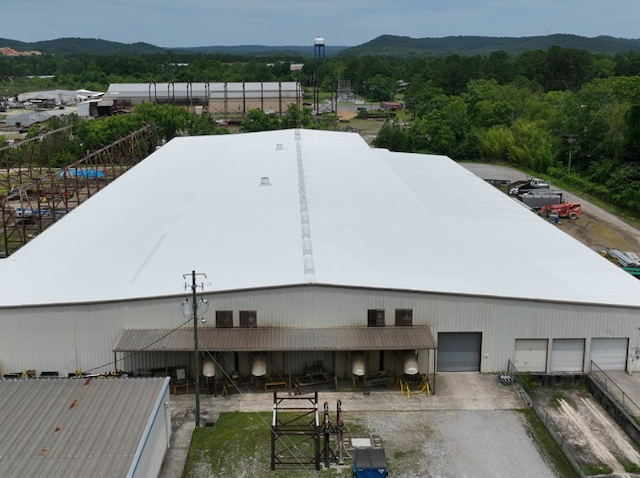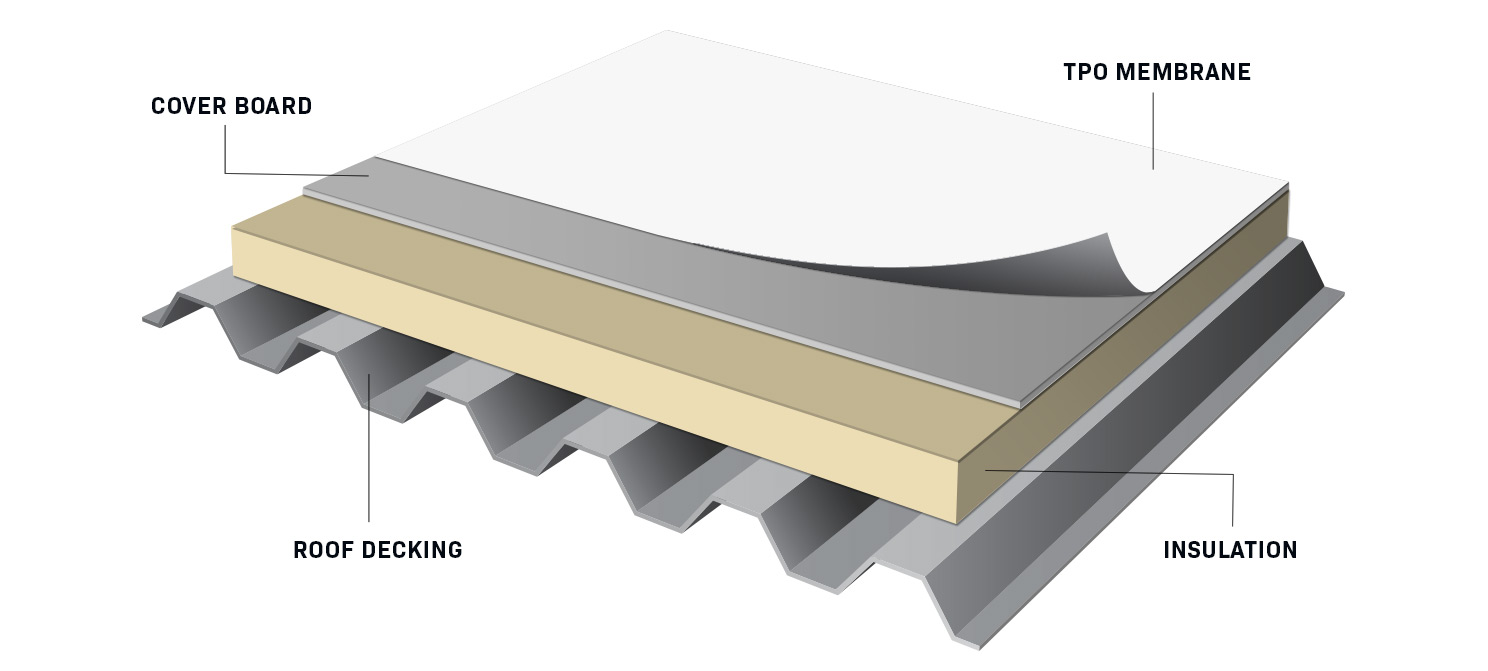Imagine you’re staring at a flat commercial roof on a blazing summer day. You can almost feel the heat bouncing off it, and you start to wonder how this roof manages to withstand such conditions year after year. This is where TPO roofing comes into play.
TPO roofing, or thermoplastic polyolefin, is a single-ply roofing membrane known for its energy efficiency, flexibility, and durability.
It’s a popular choice for flat or low-slope roofs due to its weather-resistant properties and ability to reflect solar heat, which can reduce cooling costs.
What makes it stand out among other roofing materials?
For those curious about modern roofing solutions, TPO roofing offers both reliability and cost-effectiveness. It strikes a balance between advanced material science and practical application. Whether you’re building new or contemplating an upgrade, understanding this material’s benefits and quirks can lead to informed decisions about roofing options.
What Is TPO Roofing?

Thermoplastic Polyolefin, or TPO, is a standout player in the roofing industry. TPO roofing involves using a single-ply membrane made primarily from polypropylene and ethylene-propylene rubber. This membrane roof is lauded for its flexibility and reliability.
You’ll often find TPO on commercial roofs, especially flat roofs. Its design allows it to be installed in large sheets. This minimizes seams and potential leak points, providing better protection.
TPO membranes are known for their white or light-colored surfaces. This reflectivity is not just for style—these membranes reflect sunlight to help maintain internal building temperatures. Who doesn’t want a cooler building in the hot summer months?
In terms of composition, TPO membranes are typically layered. Some include an anti-oxidation layer, a fireproof layer, and a non-woven fabric backing. This multi-layering contributes to their robustness and adaptability.
Chemical formulas and precise compositions may vary between manufacturers, offering different levels of thickness and durability. Does this make TPO a versatile choice? Absolutely.
In the world of industrial and commercial roofing, TPO holds a significant share due to its cost-effectiveness and long-term performance. It’s widely chosen for energy efficiency, durability, and ease of installation. TPO makes a strong case for those seeking a reliable roofing solution.
The Advantages of TPO Roofing
TPO roofing systems have become popular due to their blend of energy efficiency, ease of installation, and enduring durability.
These characteristics offer practical benefits for both commercial and residential buildings. With cost-effectiveness and positive environmental impacts, TPO stands out as a modern roofing solution.
Energy Efficiency and UV Resistance
TPO roofing is highly reflective, bouncing back sunlight and helping to keep buildings cooler. This reflectivity translates into energy savings as less air conditioning is required, especially in warmer climates. TPO membranes are designed with UV resistance, further enhancing their efficiency.
UV rays are notorious for degrading roofing materials, but TPO resists these effects, prolonging its lifespan. As a result, buildings maintain consistent energy consumption and owners see lower electricity bills.
Ease of Installation and Versatility
TPO’s lightweight and flexible nature makes it surprisingly easy to install. Contractors appreciate this aspect, as it reduces labor time and complexity. The membrane can be mechanically attached, fully adhered, or even ballasted based on the needs of the structure. This means fewer complications and a smoother process all around.
With versatility comes adaptability. TPO suits many building types, whether flat roofs or those with low slopes. Plus, it is a top choice for winter installations, thanks to its heat welding capabilities.
Cost-Effectiveness
When it comes to value for money, TPO offers a lower installation cost compared to many other roofing materials. This affordability is a major draw for budget-conscious property owners. Additionally, its reflective nature not only saves on immediate costs but also provides long-term savings on energy expenses.
Expect minimal maintenance costs as well. The initial investment pays off with reduced expenses over its life.
Durability and Puncture Resistance
TPO is built to last. Its durability stands up to tears, punctures, and regular wear and tear. This resilience ensures that the roof can withstand both weather elements and physical impacts without frequent repairs.
Its chemical composition provides excellent resistance against mold and dirt accumulation, keeping the roof looking good and functioning well. Longevity is assured when installed correctly and maintained.
Environmental Benefits
With an eye on sustainability, TPO roofing contributes to an environmentally friendly approach. It’s fully recyclable at the end of its life cycle and often contains no chlorine, minimizing its ecological footprint. Choosing TPO supports green building standards and LEED certifications.
The reflective qualities also reduce the urban heat island effect, which is common in cities. By lessening energy needs, TPO indirectly reduces carbon emissions from power plants.
The Disadvantages of TPO Roofing
TPO roofing, while popular, isn’t without its setbacks. Users often find issues with longevity and performance during extreme weather conditions.
Longevity Concerns
One of the primary disadvantages of TPO roofing is its lifespan. Typically, TPO roofs last about 10 to 20 years. Compared to other materials like metal or asphalt shingles, which can last between 20 to 50 years, TPO falls short. This shorter service life can lead to higher maintenance and replacement costs long-term.
The youth of TPO as a roofing technology is another contributing factor. As it has been in use for only a few decades, the long-term durability is still under scrutiny. Manufacturers are continuously improving formulas, but this leads to inconsistency across products.
Performance in Extreme Temperatures
TPO roofing may also struggle in extreme temperatures. While it is generally UV-resistant and reflects heat, some formulations have shown issues under very high heat conditions. For instance, the membrane can expand or become brittle, leading to potential cracks or leaks.
Cold weather can present challenges as well. TPO membranes might stiffen in low temperatures. This stiffness can increase susceptibility to damage under stress, such as heavy snowfall or ice accumulation. These vulnerabilities make it crucial for consumers to choose the right TPO formulation based on their specific climate conditions.
TPO Installation Process
Installing TPO roofing involves several key steps that ensure the roof is both functional and durable. It’s crucial to prepare the roof, attach the membrane securely, and weld the seams properly for a long-lasting result.
Preparation and Insulation
Before laying down the TPO membrane, proper preparation is essential. The existing roof surface must be clean, smooth, and free of debris or sharp objects that could potentially damage the membrane. Any loose materials or old roofing must be removed.
If insulation is part of the plan, it will be installed at this stage. Commercial roofs might use various insulation thicknesses based on client specifications, often ranging from a half-inch to several inches.
This layer not only helps with energy efficiency but also provides a smooth surface for the TPO membrane. High-quality insulation ensures the roof performs well over its lifespan.
Attaching the Membrane
The membrane attachment can be done via several methods, each with its own set of tools and techniques. In mechanical attachment, fasteners and plates secure the membrane to the roof deck.
This approach is often used for its reliability and ease of installation. For those who prefer adhesive application, an adhesive is applied directly to the deck or insulation, bonding the membrane tightly.
This method requires precision to avoid bubbles and ensure adherence. Finally, there’s the ballasted installation, where the membrane is held in place with ballast like gravel. Each method suits different roof designs and client needs, making it important to choose based on specific project goals.
Seam Welding
Once the membrane is laid out and attached, the seams need to be welded. This is achieved using hot-air welders, which fuse the overlaps of the membrane, ensuring a watertight seal. Proper seam welding is crucial, as it prevents leaks and extends the roof’s life. The process requires skill and knowledge, as improper welding can lead to roof failures over time. Technicians typically check seams for uniformity, looking for proper bonding without missing spots.
Continual checks during the welding process help identify weak areas, ensuring the entire roof is secure and leak-proof. Keep that welder steady for solid seams!
Comparing TPO to Other Roofing Options
TPO roofing is known for its energy efficiency and cost-effectiveness. When pitted against other materials like EPDM and PVC, it reveals unique strengths and considerations that affect the decision-making process for selecting a roofing system.
TPO vs EPDM
EPDM, a synthetic rubber membrane, has been a staple in the roofing industry for years. It’s flexible and performs well in various weather conditions. TPO, in contrast, offers better energy efficiency due to its reflective properties.
When it comes to installation, TPO is typically lighter than EPDM, which might make the handling process easier. That can be a boon for installers. Yet, EPDM is known for its simplicity in patching and repairs, thanks to its rubbery texture.
Cost-wise, both are considered affordable options compared to others, but TPO often provides more savings through reduced cooling costs. TPO’s seams, bonded by heat welding, generally offer greater resistance to water intrusion than EPDM’s adhesive seams.
TPO vs PVC
PVC is another popular choice, particularly appreciated for its durability and fire resistance. It boasts excellent wear characteristics but often comes at a higher price point than TPO. TPO can often offer similar durability benefits without the premium price.
Both TPO and PVC are heat-reflective and energy efficient. They are often used in commercial settings where reducing building cooling loads is a priority. However, their chemical compositions differ: PVC can sometimes release chlorine over time, while TPO is considered a more environmentally friendly option.
Installation techniques somewhat overlap, with both involving heat-welded seams. Yet, PVC’s thicker composition can make it more complex to install, which may lead to increased labor costs.
Cost Considerations for TPO Roofing

When it comes to TPO roofing, costs are a critical concern for homeowners and builders. The price largely depends on factors like roof size, complexity, and the condition of the current roof deck.
- Cost per Square Foot: For TPO roofing, expect to pay between $7 and $12 per square foot, which generally includes materials and installation. Lower-end prices, around $3.50 to $4.00 per square foot, often apply to large commercial projects. These figures highlight the affordable nature of TPO roofing in comparison to other roofing types.
- Pricing Comparisons: Compared to PVC roofing, TPO generally costs less while still offering durability and weather resistance. It is frequently positioned as a more budget-friendly alternative for those looking for a white single-ply roofing system. The cost of PVC roofing can sometimes exceed TPO for similar project sizes and specifications.
- Factors that Help Lower Costs: Economies of scale apply here. Larger projects typically benefit from a reduced cost per square foot. Additionally, opting for a ballasted TPO system might offer some savings, especially for large, flat installations. Supervision by a seasoned contractor can also avoid costly mistakes during installation, ensuring a better return on investment.
- A Few Additional Pointers: It’s worth noting that TPO is generally not suitable for steep-sloped roofs. Consulting with a professional can clarify whether TPO is the right choice for specific roofing needs, which ultimately influences the overall cost effectiveness of the project.
Maintaining Your TPO Roof

Regular upkeep of your TPO roof extends its lifespan, ensuring that it withstands harsh weather conditions and remains energy efficient. This involves inspections, repairs, and cleaning tailored to the unique nature of TPO membranes.
Regular Inspections
Keeping an eye on TPO roofing through regular inspections is vital. These membranes can face wear from UV exposure, thermal expansion, and foot traffic. Inspections identify potential issues before they escalate. Checking the perimeter for loose edges, the seams for separation, and overall surface for dirt accumulation can save headaches down the road
While walking on the roof, make sure to look for signs of aging or thinning. Pair inspections with seasonal weather changes to stay ahead of any weather-related damage. Thorough inspections should be part of routine maintenance schedules.
Repairing Punctures and Tears
Even small punctures and tears in TPO membranes can lead to significant issues if not addressed promptly. A quick response to any damages can prolong the roof’s life. Spotting visible punctures or tears early allows for timely repairs. Fixing involves cleaning the area with a TPO-compatible cleaner and applying a patch or sealant. Regularly monitor high-traffic areas, as they are more susceptible to damage.
Trained professionals have the skills to handle repairs correctly, ensuring a solid, watertight fix. Relying on professional expertise is best for those unfamiliar with repair techniques. Repairing even minor issues promptly keeps costly problems at bay.
Cleaning and Maintenance
Regular cleaning prevents dirt, debris, and organic growth from deteriorating the TPO surface. Always use non-abrasive cleaning methods—soft brooms and water are your allies. Avoid harsh chemicals that can compromise the membrane. Incorporate detergents approved for TPO to help maintain the finish and enhance reflectivity.
Focus on keeping drains clear to prevent water accumulation. Protect curbs and penetrations during cleaning to avoid leakage. Maintenance checks should include looking for signs of staining or discoloration that might suggest a need for deeper cleaning. Regular attention to cleanliness helps maintain both the appearance and performance of TPO roofs.
Choosing the Right Roofing Contractor
Selecting the right roofing contractor is pivotal for a successful TPO roofing project. He or she should possess substantial experience, especially with TPO systems. Why does experience matter? It ensures quality and minimizes installation problems. Looking for a contractor with a solid track record can make a world of difference.
- Certifications are one signpost of quality. Certified installers are often more reliable, offering a guarantee of expert installation. Would you compromise on quality when your roof’s longevity depends on it?
- Checking references is not just a formality—a good contractor will happily provide references from past clients. It’s a chance to hear firsthand about the contractor’s reliability and professionalism. This feedback can provide insights you won’t find in brochures or online reviews.
- Additionally, make sure that the contractor provides a detailed written estimate. This should include material costs, labor, and estimated completion time. A written agreement protects both parties and clarifies expectations. He or she should not hesitate to explain each part of the agreement.
- Finally, make sure they communicate well. A contractor who is accessible and transparent can save you a lot of headaches. Good communication leads to a smooth project, while poor communication can escalate small issues into major problems. So, is the roofing contractor easy to reach and cooperative?
Future of TPO in the Roofing Market
TPO roofing has clearly gained traction in recent years, especially in the commercial roofing market. It stands out due to its energy-efficient properties and eco-friendliness, which appeal to businesses aiming to reduce costs and their environmental footprint.
Market Trends continually point towards TPO as a popular choice for flat and low-slope roofs. This preference is largely driven by its durability and adaptability, traits that make TPO ideal for modern commercial structures.
Innovations in TPO technology have sparked interest among building owners and contractors. These developments focus on improving UV resistance and broadening color choices, enhancing both energy efficiency and aesthetics.
Manufacturers are now exploring advanced installation techniques. Seamless methods are coming up, which make TPO more reliable and easier to install. These innovations contribute significantly to the roof’s lifespan and performance.
As construction methodologies evolve, TPO remains a competitive roofing solution. Its growth in the industry is supported by its blend of flexibility, cost-effectiveness, and resilience against harsh weather conditions.
The demand for TPO in commercial roofing is anticipated to rise. Not just because it’s practical, but because it aligns with the growing focus on sustainable building practices. In a world where green solutions are not just preferred but necessary, TPO plays its part well.
Need a Reliable Roofing Contractor? Pickle Roofing Can Help.
TPO roofing offers a practical and efficient solution for various roofing needs. With its energy efficiency, this material stands out by helping to reduce cooling costs. TPO’s contributions certainly help mitigate it.
Durability and weather resistance make TPO a trustworthy choice for those seeking a long-lasting roofing option. This roof type endures harsh weather conditions, extending the life span of a building’s roof while minimizing maintenance efforts.
Need help deciding if TPO roofing is right for you? Reach out to Pickle Roofing at (469) 373-3985 for expert advice and assistance.

